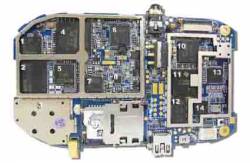 Neo FreeRunner (GPS chip, lower left, #3)
Neo FreeRunner (GPS chip, lower left, #3)Okay, they’re really serious about open source.
Mobile device manufacturer Openmoko has announced that it will publish the schematics for the company’s Neo 1973 and Neo FreeRunner mobile phones, further opening its mobile platform to the development community.
u-blox AG, Switzerland, maker of the GPS chip — the u- ANTARIS 4 ATR0635 — used in the Neo FreeRunner, endorsed Openmokos publishing the complete schematics for the GPS chip in the Neo FreeRunner phones.
Okay, they’re really serious about open source.
Mobile device manufacturer Openmoko has announced that it will publish the schematics for the company’s Neo 1973 and Neo FreeRunner mobile phones, further opening its mobile platform to the development community.
u-blox AG, Switzerland, maker of the GPS chip — the u- ANTARIS 4 ATR0635 — used in the Neo FreeRunner, endorsed Openmokos publishing the complete schematics for the GPS chip in the Neo FreeRunner phones.
The schematics now document how the GPS chip is wired into the system, providing vital information for developers who want to leverage the GPS functionality for new designs involving the Openmoko phones. Details on the FreeRunner hardware can be found on-line at <http://wiki.openmoko.org/wiki/Neo_FreeRunner_GTA02_Hardware>.
Openmoko broke with traditional mobile phone manufacturers by shipping its Neo 1973 and Neo FreeRunner mobile phones with a free and open source (FOSS) operating system and open applications, enabling developers to take the functionality of the phone well beyond the limited applications that commercial mobile phones can handle. The Neo FreeRunner went on sale July 4 and sold out the initial allocation in less than a week, according to Openmoku.
Openmoko has previously published the CAD files for the product under a Creative Commons license so that product designers could alter the look and feel of the phone case and craft it to suit such vertical markets as fashion, science, medical, industrial, or enterprise.
Now, the company says it will publish the schematics of the phone, giving engineers free reign to modify Neo phones. Just as FOSS provides source code information, open schematics provide vital information to engineers who may want to add functionality, external instruments or sensors, or assist the company in debugging problems, ultimately creating a better product for the entire mobile community.
“We fully support Openmoko’s decision to publish the schematics of the u-blox GPS receivers,” says u-blox CEO, Thomas Seiler. “It is vitally important that developers have access to this data, and it improves product quality. Going forward we think that more manufacturers and more consumers will demand open architecture products with optimum performance.”
“Why should industry be afraid of opening up its design?” asked Openmoko CEO, Sean Moss-Pultz. “Schematics are simply another form of documentation and vital to future success, service and satisfaction in the market. We believe our products would be incomplete without them."
Release of the schematics will covered under a Creative Commons license and files will be posted in due course on <openmoko.com> and <openmoko.org>. Openmoko is showing the Neo FreeRunner at LinuxWorld Expo August 5-7 in San Francisco, California. at booth 1625 and at the LinuxWorld Garage 1234.
The Neo FreeRunner has been selected as a finalist the LinuxWorld Product Excellence Awards, to be presented at LinuxWorld Conference & Expo this week.





